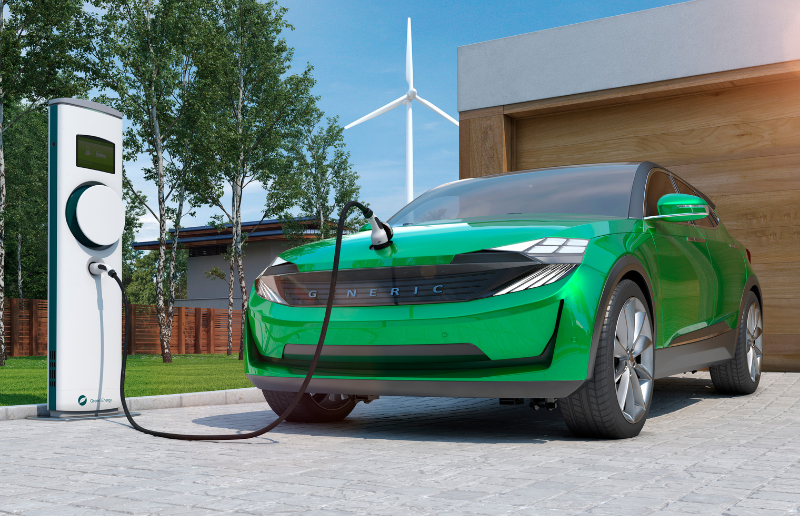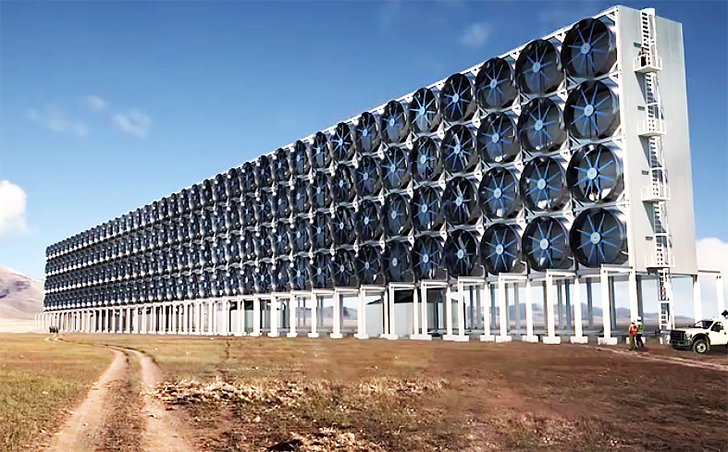How Has Technology Impacted Climate Change For Better Or For Worse?
This article takes a look at the paradoxical ideology that while the touch of applied science on the environment has been highly negative, the concept of ecology technology could salvage our planet from the harm that has been done. This idea is supported by WWF i , who have stated that although technology is a solution enabler it is also part of the trouble.
The term 'engineering' refers to the application of scientific cognition for practical purposes and the mechanism and devices adult every bit a upshot. We are currently living in a catamenia of rapid change, where technological developments are revolutionising the fashion we live, at the aforementioned time as leading usa further into the depths of catastrophe in the form of climate change and resource scarcity.
This article will brainstorm past discussing the negative impact of technology on the environment due to the causation of some of the world's most severe environmental concerns, followed by the potential that it has to salve the planet from those same bug. Finally it will explore the particular environmental technology of the gas sensor and discuss how it plays a part in the mitigation of negative ecology consequences.
The Impact of Technology on the Environs
The industrial revolution has brought about new technologies with immense power. This was the transition to new manufacturing processes in Europe and the United States, in the catamenia from nearly 1760 to 1840. This has been succeeded past continued industrialisation and farther technological advancements in adult countries around the world, and the bear on of this technology on the environment has included the misuse and damage of our natural earth.
These technologies take damaged our globe in two main ways; pollution and the depletion of natural resource.
1. Air and water pollution
Air pollution occurs when harmful or excessive quantities of gases such as carbon dioxide, carbon monoxide, sulfur dioxide, nitric oxide and methane are introduced into the earth'due south atmosphere. The chief sources all chronicle to technologies which emerged following the industrial revolution such as the burning of fossil fuels, factories, power stations, mass agriculture and vehicles. The consequences of air pollution include negative health impacts for humans and animals and global warming, whereby the increased corporeality of greenhouse gases in the air trap thermal energy in the Globe'south atmosphere and crusade the global temperature to rise.

Water pollution on the other manus is the contamination of water bodies such as lakes, rivers, oceans, and groundwater, usually due to human activities. Some of the most common water pollutants are domestic waste, industrial effluents and insecticides and pesticides. A specific example is the release of inadequately treated wastewater into natural water bodies, which can pb to deposition of aquatic ecosystems. Other detrimental furnishings include diseases such as typhoid and cholera, eutrophication and the destruction of ecosystems which negatively affects the food chain.
2. Depletion of natural resources
Resource depletion is another negative impact of engineering science on the surround. It refers to the consumption of a resources faster than it tin can be replenished. Natural resources consist of those that are in existence without humans having created them and they can exist either renewable or non-renewable. At that place are several types of resource depletion, with the most severe being aquifer depletion, deforestation, mining for fossil fuels and minerals, contagion of resources, soil erosion and overconsumption of resources. These mainly occur as a result of agriculture, mining, h2o usage and consumption of fossil fuels, all of which take been enabled by advancements in technology.
Due to the increasing global population, levels of natural resource degradation are also increasing. This has resulted in the interpretation of the world's eco-footprint to be one and a one-half times the ability of the earth to sustainably provide each individual with enough resources that meet their consumption levels. Since the industrial revolution, large-scale mineral and oil exploration has been increasing, causing more and more natural oil and mineral depletion. Combined with advancements in applied science, development and research, the exploitation of minerals has go easier and humans are therefore digging deeper to access more which has led to many resources entering into a production decline.
Moreover, the effect of deforestation has never been more severe, with the Globe Bank reporting that the cyberspace loss of global forest betwixt 1990 and 2015 was i.3 one thousand thousand km ii . This is primarily for agricultural reasons but also logging for fuel and making space for residential areas, encouraged by increasing population pressure level. Not only does this event in a loss of copse which are important every bit they remove carbon dioxide from the atmosphere, but thousands of plants and animals lose their natural habitats and have go extinct.
Ecology Engineering
Despite the negative impact of engineering science on environs, a recent rise in global concern for climate change has led to the development of new environmental technology aiming to help solve some of the biggest environmental concerns that nosotros confront as a society through a shift towards a more sustainable, low-carbon economy. Environmental technology is also known as 'green' or 'clean' technology and refers to the evolution of new technologies which aim to conserve, monitor or reduce the negative impact of applied science on the environment and the consumption of resources.
The Paris agreement, signed in 2016, has obliged nearly every land in the world to undertake ambitious efforts to combat climate change by keeping the rise in the global boilerplate temperature at less than two°C above pre-industrial levels.
This section will focus on the positive impact of engineering science on the environment as a effect of the development of environmental technology such every bit renewable energy, 'smart technology', electric vehicles and carbon dioxide removal.
- Renewable free energy
Renewable energy, also known equally 'clean free energy', is energy that is collected from renewable resources which are naturally replenished such as sunlight, wind, rain, tides, waves, and geothermal heat. Modern ecology technology has enabled us to capture this naturally occurring energy and convert information technology into electricity or useful rut through devices such as solar panels, current of air and water turbines, which reflects a highly positive touch on of technology on the environs.
Having overtaken coal in 2015 to become our second largest generator of electricity, renewable sources currently produce more than 20% of the UK's electricity, and EU targets means that this is likely to increase to 30% by 2020. While many renewable energy projects are large-scale, renewable technologies are besides suited to remote areas and developing countries, where energy is frequently crucial in human being development.
The cost of renewable energy technologies such as solar panels and wind turbines are falling and government investment is on the rise. This has contributed towards the amount of rooftop solar installations in Australia growing from approximately 4,600 households to over 1.6 million between 2007 and 2017.

- Smart technology
Smart domicile engineering science uses devices such every bit linking sensors and other appliances connected to the Internet of Things (IoT) that can be remotely monitored and programmed in order to be as energy efficient every bit possible and to respond to the needs of the users.
The Internet of Things (IoT) is a network of internet-continued objects able to collect and substitution data using embedded sensor technologies. This data allows devices in the network to autonomously 'make decisions' based on existent-fourth dimension information. For example, intelligent lighting systems only illuminate areas that require it and a smart thermostat keeps homes at certain temperatures during certain times of day, therefore reducing wastage.
This ecology technology has been enabled past increased connectivity to the internet as a result of the increment in availability of WiFi, Bluetooth and smart sensors in buildings and cities. Experts are predicting that cities of the futurity will exist places where every car, phone, air conditioner, light and more are interconnected, bringing about the concept of energy efficient 'smart cities'.

The technology of the internet further demonstrates a positive impact of technology on the environment due to the fact that social media can raise awareness of global effect and worldwide virtual laboratories tin be created. Experts from dissimilar fields can remotely share their inquiry, feel and ideas in order to come up with improved solutions. In addition, travel is reduced as meetings/communication between friends and families can be done nearly, which reduces pollution from send emissions.
- Electric vehicles
The environmental technology of the electric vehicle is propelled by i or more electric motors, using energy stored in rechargeable batteries. Since 2008, at that place has been an increase in the manufacturing of electric vehicles due to the desire to reduce environmental concerns such equally air pollution and greenhouse gases in the atmosphere.
Electric vehicles demonstrate a positive impact of technology on the environment because they do not produce carbon emissions, which contribute towards the 'greenhouse effect' and leads to global warming. Furthermore, they practice not contribute to air pollution, significant they are cleaner and less harmful to human health, animals, plants, and water.
In that location take recently been several environmental technology authorities incentives encouraging plug-in vehicles, taxation credits and subsidies to promote the introduction and adoption of electrical vehicles. Electric vehicles could potentially exist the way forwards for a greener society because companies such equally Bloomberg take predicted that they could become cheaper than petrol cars by 2024 and co-ordinate to Nissan, there are now in fact more electric vehicle charging stations in the UK than fuel stations three .

- 'Direct Air Capture' (DAC) – Environmental Technology removing Carbon from the atmosphere
For a slightly more ambitious technology to conclude with, the idea of pulling carbon dioxide directly out of the temper has been circulating climate alter mitigation research for years, however it has merely recently been implemented and is nevertheless in the early stages of evolution.
The ecology technology is known as 'Direct Air Capture' (DAC) and is the process of capturing carbon dioxide directly from the ambient air and generating a concentrated stream of CO2 for sequestration or utilisation. The air is so pushed through a filter by many large fans, where CO2 is removed. It is thought that this applied science can be used to manage emissions from distributed sources, such as exhaust fumes from cars. Total-scale DAC operations are able to blot the equivalent corporeality of carbon to the annual emissions of 250,000 average cars.
Many argue that DAC is essential for climate change mitigation and that it can help reach the Paris Climate Understanding goals, as carbon dioxide in the air has been the master cause of the problem after all. However, the loftier cost of DAC currently ways that it is not an option on a large calibration and some believe that reliance on this applied science would pose a chance as it may reduce emission reduction equally people may exist under the pretense that all of their emissions will only exist removed.

Image source: http://www.texasvox.org/straight-air-capture-co2-climate-solution-limitations/
Although we cannot contrary the negative impact of engineering science on the environs caused by industrialisation, many believe that new ecology engineering science, such every bit renewable free energy combined with smart logistics and electric send, has the potential to bring about the rapid decarbonisation of our economy and the mitigation of farther detrimental impairment.
How can the environmental applied science of Edinburgh Sensors' Gas Sensor contribute?
Sensors play a huge part in the positive impact of technology on the surroundings as they often play a vital part in the monitoring and reduction of harmful activities. At Edinburgh Sensors, we produce bespoke gas sensing technology which can exist used across a wide range of applications, many of which can be used to mitigate environmental concerns. This article presents merely three of these applications; the monitoring of greenhouse gas emissions, the monitoring of marsh gas using an infrared sensor and the detection of gases using a UAV drone.
- Monitoring of Greenhouse Gas emissions: https://edinburghsensors.com/news-and-events/measuring-greenhouse-gas-emissions/
Edinburgh Sensors Gascard NG provides high quality, accurate and reliable measurements of CO, CO2 and CH4. To detect out how we can assist you with the measurement of greenhouse gas emissions, only contact the states.
- Using an Infrared Sensor for reliable Methane monitoring: https://edinburghsensors.com/news-and-events/infrared-sensor-gas-monitoring/
Edinburgh Sensors' Gascard NG is used for methane detection in a range of research, industrial, and environmental applications including pollution monitoring, agronomical research, chemical processes and many more.
- Using a UAV drone attached to a gas sensor to measure harmful gases: https://edinburghsensors.com/news-and-events/uav-drone-methane-monitoring/
From monitoring global warming to tracking the spread of pollution, at that place are many reasons to utilise a drone in order to monitor carbon dioxide, methane and other hydrocarbon gas concentrations in remote or unsafe locations.
Arrive impact
If you have enjoyed reading this commodity about the impact of environmental technology and technology on the environment , why not join Edinburgh Sensors on social media and sign up to our infrequent newsletter to be the first to know almost our latest products, research and developments.
Or if you accept just equally many concerns about the touch on of technology on the environment as nosotros practice and are interested in using gas sensing applied science to play a part in the reduction of environmental harm, we encourage yous to arrive touch with a member of our team today as we would be delighted to help you lot.
References
- Proudfoot, R. and Kelley, S. (2017). Can applied science save the planet? WWF Australia https://www.wwf.org.au/ArticleDocuments/360/pub-can-technology-salve-the-planet-30may17.pdf.aspx?Embed=Y
- Nunez, C. (2019). Climate 101: Deforestation. National Geographic. https://www.nationalgeographic.com/environment/global-warming/deforestation/#targetText=Between%201990%20and%202016%2C%20the,written report%20in%20the%20journal%20Nature
- Visor, D. (2019). Electric car charging stations surpass number of fuel stations in less than 100 years since Uk's first petrol pump installed. Nissan News. https://great britain.nissannews.com/en-GB/releases/release-c2df391cdf0dd0c30a0575ffb50231f8-united kingdom of great britain and northern ireland-ev-charging-stations-surpass-number-of-fuel-stations#
Source: https://edinburghsensors.com/news-and-events/impact-of-technology-on-the-environment-and-environmental-technology/
Posted by: hernandezantionne.blogspot.com


0 Response to "How Has Technology Impacted Climate Change For Better Or For Worse?"
Post a Comment